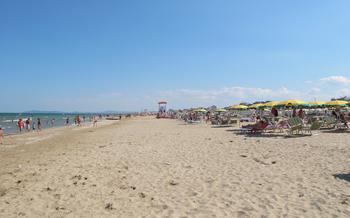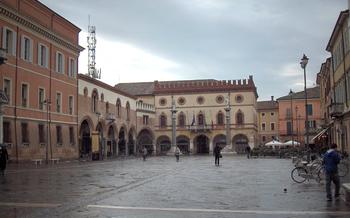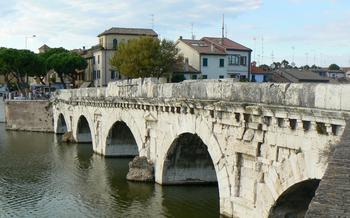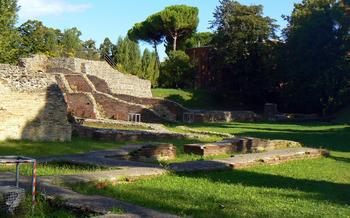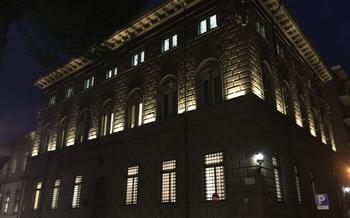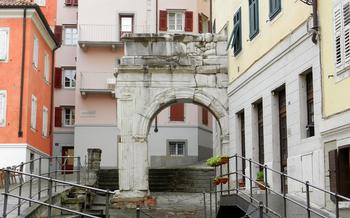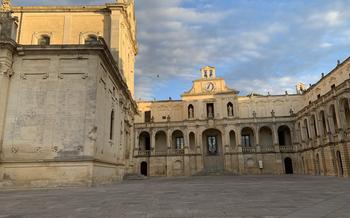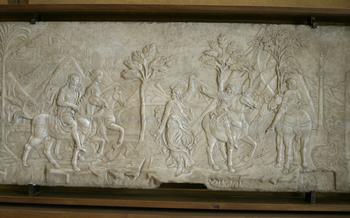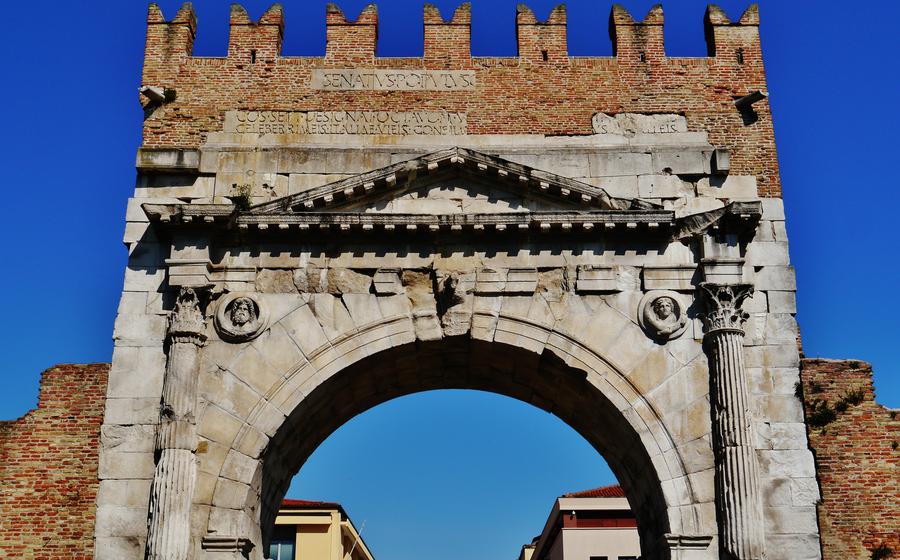
Arch of Augustus (Arco d'Augusto)
- A Journey Through Time: Unveiling the Arch of Augustus in Rimini
- Historical Background
- Location and Accessibility
- Physical Description
- Historical Significance
- Function and Purpose
- Restoration and Preservation
- Visitor Experience
- Surrounding Area
- Historical Context of Rimini during the Roman Empire
- Cultural Significance
- Legends and Myths
- Art and Architecture
- Insider Tip: Unveiling Hidden Treasures
A Journey Through Time: Unveiling the Arch of Augustus in Rimini
Rimini, a captivating coastal city nestled in the heart of Emilia-Romagna, Italy, boasts a rich tapestry of history, culture, and architectural wonders. Among its many treasures, the Arch of Augustus stands as a testament to the city's glorious past and serves as a gateway to its vibrant present. This majestic arch, a symbol of Roman power and prestige, invites travelers to embark on a journey through time, immersing themselves in the grandeur of the ancient world. With its intricate carvings, imposing structure, and enduring legacy, the Arch of Augustus promises an awe-inspiring encounter that will leave visitors spellbound.
Historical Background
Rimini's history is deeply intertwined with the Roman Empire. In 268 BCE, the city became a Roman colony, known as Ariminum. Under Roman rule, Rimini flourished as a strategic military and commercial center, thanks to its position on the Via Flaminia, the main road connecting Rome to the Adriatic Sea.
Emperor Augustus played a crucial role in Rimini's development. In 27 BCE, he ordered the construction of the Arch of Augustus to celebrate the completion of the Via Flaminia and commemorate his victories in the Cantabrian Wars. The arch served as a symbol of Roman power and prestige, and its imposing presence marked the gateway to the city.
Location and Accessibility
The Arch of Augustus stands majestically in the heart of Rimini's historic center, at the intersection of Corso Augusto and Via IV Novembre. This prominent location reflects the arch's significance as a gateway to the ancient city of Ariminum. Visitors can conveniently reach the arch on foot, as it lies within easy walking distance from most hotels and attractions in Rimini's Old Town. For those arriving by public transportation, the nearest bus stop, "Arco d'Augusto," is just a few steps away. The arch's proximity to other notable landmarks, such as the Piazza Cavour and the Museo della Città, makes it an ideal starting point for exploring Rimini's rich cultural heritage.
Physical Description
The Arch of Augustus stands as a testament to Roman architectural prowess and artistic grandeur. Constructed from gleaming white Istrian stone, the arch rises to an impressive height of 9 meters, commanding attention with its imposing presence. Its sturdy structure is composed of two massive piers adorned with intricate carvings, supporting a barrel vault that spans 7 meters in width.
The archway itself is 4 meters in height, providing a grand entrance to the ancient city of Ariminum. The arch's facade is adorned with a series of bas-reliefs, which depict scenes of Roman military victories, mythological tales, and religious ceremonies. The carvings showcase the remarkable precision and attention to detail that characterized Roman craftsmanship and artistic expression. The arch's symbolism is evident in the intricate carvings that adorn its soffit, representing the transition from the earthly realm to the divine.
Historical Significance
The Arch of Augustus stands as a testament to the enduring legacy of Roman civilization. Erected during the reign of Emperor Augustus in 27 BC, the arch served as a triumphal arch, commemorating the victories and achievements of the Roman Empire. It was strategically positioned at the entrance to the ancient city of Ariminum, marking the end of the Via Flaminia, a major Roman road connecting Rome to the Adriatic coast.
The arch's imposing presence and intricate carvings symbolized the power and prestige of the Roman Empire. Its bas-reliefs depict scenes of military triumphs, including the subjugation of conquered peoples and the glory of the Roman legions. These elaborate carvings served as a powerful reminder of Roman authority and the consequences of defying their rule.
Over the centuries, the Arch of Augustus has witnessed countless historical events, from the rise and fall of empires to the transformation of Rimini into a vibrant modern city. It has stood steadfast, a silent observer of history's unfolding drama, and continues to inspire awe and admiration in visitors from around the world.
Function and Purpose
Originally conceived as a triumphal arch, the Arch of Augustus served as a ceremonial gateway to the ancient city of Ariminum. With its imposing presence, it symbolized the might and glory of the Roman Empire, marking the achievements and victories of its legions. As the city grew, the arch became a focal point for public celebrations, parades, and processions. It served as a stage for the display of imperial power, showcasing the grandeur and opulence of Roman culture. Over time, the arch evolved into a symbol of civic pride and identity for the people of Rimini, representing the enduring legacy of their Roman heritage.
Restoration and Preservation
The Arch of Augustus has undergone several restoration and preservation efforts over the centuries. The most significant restoration took place in the 18th century when the arch was in danger of collapse. The work involved reinforcing the structure, repairing damaged elements, and cleaning the intricate carvings. In the 20th century, further restoration efforts were carried out to address the effects of weathering, pollution, and vandalism. These efforts have helped to preserve the Arch of Augustus as a symbol of Rimini's rich history and cultural heritage.
One of the challenges faced in preserving the arch is the need to balance the conservation of its original fabric with necessary repairs and interventions. The arch has been exposed to centuries of wear and tear, as well as damage caused by earthquakes and warfare. Restorers must carefully assess which elements can be preserved in their original state and which require intervention to ensure the arch's structural integrity.
The preservation of the Arch of Augustus is of utmost importance as it represents a tangible link to Rimini's past. It stands as a testament to the enduring legacy of the Roman Empire and serves as a reminder of the city's historical significance. By preserving this iconic landmark, we ensure that future generations can continue to appreciate its architectural beauty and historical value.
Visitor Experience
Standing beneath the imposing Arch of Augustus is a truly immersive experience that transports visitors back in time. The sheer size and grandeur of the arch are awe-inspiring, and the intricate carvings that adorn it offer a glimpse into the artistic and cultural prowess of the Roman Empire. Visitors can take their time to admire the bas-reliefs, which depict scenes from Roman history and mythology, and appreciate the intricate details that make this monument so unique. Capturing the moment with a photograph is a must, as it will serve as a lasting reminder of this unforgettable encounter with history.
Surrounding Area
The Arch of Augustus stands proudly in Piazza Tre Martiri, a lively public square that bustles with activity. The square is adorned with historical buildings, each with its own unique charm. Take a leisurely stroll around the piazza, admiring the architectural details and soaking in the vibrant atmosphere.
For a delightful culinary experience, step into one of the cozy restaurants or cafes that line the square. Savor authentic Italian cuisine, indulge in freshly baked pastries, or sip on a refreshing cappuccino while watching the world go by.
Don't miss the opportunity to explore the surrounding area, which offers a treasure trove of attractions. Immerse yourself in the fascinating world of marine life at the nearby Aquarium of Cattolica, encounter the wonders of the universe at the Planetarium of Rimini, or marvel at the stunning works of art at the Museo della Città.
For a truly unforgettable experience, time your visit to coincide with one of the many festivals and events held in Rimini throughout the year. These vibrant celebrations offer a unique glimpse into the city's rich culture and traditions. From the colorful pageantry of the Sagra della Madonna del Mare to the lively music and dancing of the Notte Rosa, there's always something special happening in Rimini.
Historical Context of Rimini during the Roman Empire
Rimini's prominence in ancient times stemmed from its strategic location along the Via Flaminia, the Roman road that connected Rome to the Adriatic coast. The city served as a vital military and commercial hub, facilitating the movement of troops and goods throughout the vast Roman Empire.
As a strategic outpost, Rimini played a crucial role in defending the northern borders of the empire against foreign invasions. Its sturdy fortifications and proximity to important trade routes made it a pivotal center for military operations and logistics.
Furthermore, the city's vibrant commercial activity attracted merchants and traders from across the Mediterranean. Its favorable harbor allowed for the exchange of goods between Italy and the eastern provinces, contributing to Rimini's flourishing economy and cosmopolitan atmosphere.
Cultural Significance
The Arch of Augustus holds immense cultural significance as a symbol of Roman triumph and power. It stands as a testament to the grandeur and ambition of the Roman Empire, serving as a physical embodiment of their military prowess and political dominance. The arch's impressive architecture, with its intricate carvings and inscriptions, reflects the Romans' mastery of engineering and their commitment to artistic excellence.
Moreover, the Arch of Augustus has influenced subsequent architectural styles throughout history. Its design elements, such as the triumphal arch form, the use of bas-reliefs, and the incorporation of inscriptions, have been adopted and adapted by later civilizations. The arch's enduring impact on architecture underscores its cultural significance as a touchstone for artistic and aesthetic inspiration.
Legends and Myths
The Arch of Augustus has been the subject of numerous legends and myths over the centuries, adding to its mystique and charm. One popular legend tells of a young woman named Lucia who was unjustly accused of a crime and sentenced to death. As she was being led to her execution, she passed beneath the arch and prayed to the Virgin Mary for salvation. Miraculously, the arch began to glow and the chains binding Lucia shattered, allowing her to escape.
Another legend tells of a mysterious figure known as the "Blacksmith of Rimini" who was said to have forged the arch's iron gates. According to legend, the blacksmith was a skilled craftsman who made a pact with the devil to gain his extraordinary abilities. However, the devil demanded a heavy price: the blacksmith's soul. The blacksmith eventually outsmarted the devil and kept his soul, but the devil's mark remained on the arch in the form of a small indentation.
These legends and myths have been passed down through generations, adding to the rich cultural heritage of Rimini and the Arch of Augustus. They serve as a reminder of the arch's enduring significance and its ability to capture the imagination of visitors.
Art and Architecture
The Arch of Augustus stands as a testament to the artistic and architectural prowess of the Roman Empire. Its intricate bas-reliefs depict scenes of Roman victories, religious ceremonies, and mythological tales, offering a glimpse into the cultural and historical narrative of the era. The arch's construction showcases the Romans' mastery of engineering and their attention to detail, employing techniques such as stone carving, mortar bonding, and the use of arches and vaults. The arch's architectural style, characterized by its classical proportions and harmonious composition, reflects the Romans' deep appreciation for aesthetics and order. By studying the Arch of Augustus, we gain insights into the artistic and cultural heritage of ancient Rome and its profound influence on Western civilization.
Insider Tip: Unveiling Hidden Treasures
As you explore the Arch of Augustus, take a moment to venture down a hidden alleyway just a few steps away. This secret spot will lead you to a charming, family-run trattoria that serves authentic Riminese cuisine. Indulge in the delectable flavors of handmade pasta, fresh seafood, and traditional desserts, all prepared with love and local ingredients. For the ultimate experience, visit during the annual Festa del Mare (Seafood Festival) in September when the streets come alive with vibrant celebrations, live music, and mouthwatering seafood delights.
